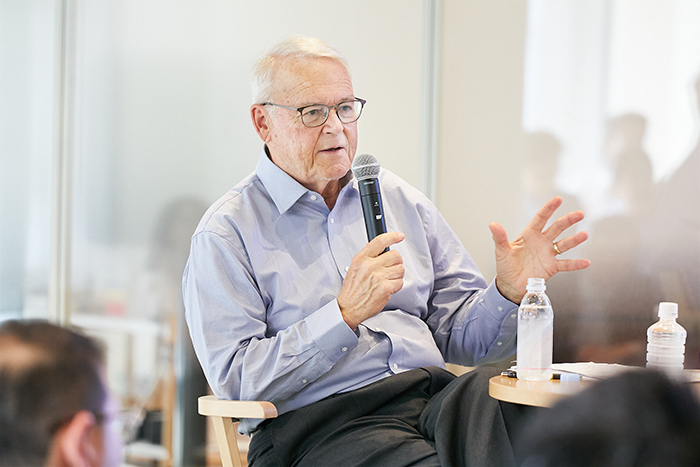Professor David Aaker, known as the "Father of Branding," is a global authority on brand theory who has long studied the relationships between companies, brands, and consumers. Due to his connection as an advisor to Dentsu Inc. for about 10 years starting in 2002, a Q&A session was held at Dentsu Inc. headquarters in October 2019 during his first visit to Japan in five years. Here is a digest of that session. The interviewer is Reiko Ogata from Dentsu Inc. Solution Development Center.

Professor David Aaker (left) and Reiko Ogata of Dentsu Inc.
Brands as a Management Issue Closely Linked to Business Strategy
Ogata: "It has been about 30 years since Professor Aaker first proposed in the late 1980s that 'by viewing brands as corporate assets and managing them correctly and strategically, it is possible to grow corporate value and business.' How have the role and meaning of brands changed?"
Aaker: The concept of brand management itself has existed since the 1930s. However, back then, it was used in a tactical or promotional sense for communication. Over the past few decades, though, the need arose not just for brands for individual products, but for brands to unify multiple product groups. Furthermore, managing brands globally, not just within a single country, became necessary. Consequently, it became essential to consider the overall business strategy, not just tactical matters like advertising campaigns or promotions.
As a result, brand strategy has become a matter decided not by brand managers, but by CMOs (Chief Marketing Officers) and even top executives. We've entered an era where you cannot formulate a communication strategy without correctly understanding brand strategy aligned with business strategy.
Ogata: Various companies publish rankings measuring brand power. How do you view the trends in these rankings?
Arker: When examining these rankings, it's crucial to consider the proportion of brand value that truly stems from the brand itself. Companies with strong performance and large sales volumes often rank highly despite minimal brand investment. In such cases, a high ranking does not necessarily equate to strong brand power.
Recent brand surveys consistently show tech brands like Amazon, Google, and Apple dominating the top positions. These brands aren't just thriving in business; they're consistently perceived by consumers as innovative and dynamic. Each has fundamentally reshaped consumer lifestyles, becoming indispensable and irreplaceable parts of daily life. This clearly signals a shift in what defines a strong brand.

Ogata: What are the common traits of today's "strong brands"?
Arker: Amazon, Google, and others continuously pursue enhancing functional value and increasing convenience, creating unique value. Looking at other brands, powerful ones all attract customers beyond functionality. They build connections with consumers through brand personality, worldview, and resonance with purpose (brand philosophy, the world they aim to create).
Brand strength measured by "Relevance" (customer attachment)
Ogata: You propose the "Brand Relevance Index" as a new metric for measuring brand strength, indicating a brand's connection with customers. Could you explain the thinking behind this?
Arker: Brand surveys targeting the general public often include samples where people merely recognize the brand name—they've never used it, let alone know anything beyond the name. Consequently, long-established brands with high market share and high visibility tend to rank highly, but this doesn't measure true brand strength.
Brand awareness and recognition are certainly important, but brand strength should fundamentally be measured by the user base. The most critical factors are: how large is the volume of loyal users among the users, and how loyal are they? It's about seeing what aspects of the brand they value, how much affection they have for the brand, and what kind of relationship they have with it.
The Brand Relevance Index from Prophet, where I serve as Vice Chairman, measures brand strength by targeting respondents who not only know the brand but are also users or have considered using it.
We assess the strength of brand attachment and the relationship with core users through perspectives like: "essential to my daily life," "overwhelmingly practical," "inspiring," and "constantly evolving." Using this measurement approach reveals that brands outside the IT/digital services sector can rank highly, while others with high awareness or usage rates may rank low.
New Brand Communication Through the Lens of "Story"
Ogata: In Japan, your latest book, "Brands That Tell Stories," was released in October 2019. What prompted you to focus on "story" as your subject?
Aaker: The original inspiration was my eldest daughter, Jennifer. She has taught a "Storytelling" class for seven or eight years as a professor in the MBA program at Stanford University. She convinced me that in this era of information and stimulus overload, the key to becoming memorable is storytelling.
Brands that tell compelling stories first capture people's memories. Data also proves that stories not only spark interest and empathy but also deliver tangible business results. As digital content becomes central to building customer relationships through branding, stories grow increasingly vital.
Ogata: What makes a good story?

Arker: First, it must be narrative-driven. Instead of listing features or appeal points, it should be told in your own words—not exactly "Once upon a time..." but still in your own voice. Second, the story itself shouldn't just be a nice tale; it must contain elements of surprise, emotion, or discovery that make people want to share it.
And above all, the crucial perspective is whether it's crafted strategically. What do you want the audience to perceive? Is it a commitment to quality? A lofty vision? Sometimes incorporating numbers or facts can be more effective for driving home the message you want to convey. It requires thinking about what effect you're aiming for and what kind of story is appropriate to achieve it.
Ogata: As branding shifts toward a digital-centric, content-driven era, what role will be expected of advertising agencies like ours?
Arker: First, we must convince clients of the effectiveness of storytelling. Then, we must identify seeds for compelling stories—what we call "signature stories" (stories that move hearts)—and craft them more attractively. Finally, we must consider how to communicate them to the target audience. This demands expertise equal to or greater than planning traditional advertising campaigns. The role of creating stories and devising strategic ways to utilize them will be extremely important going forward.
Ogata: So, it's about creating stories that resonate and stick in people's minds from the audience's perspective—not just what we want to say—and then strategically planning how to deliver them. Thank you very much for today.








